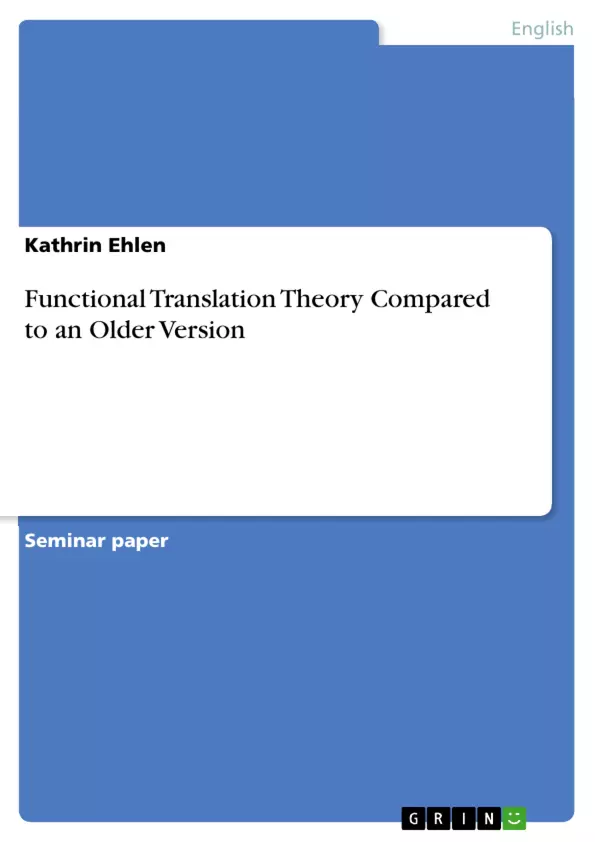1. Introduction
"Translation ist eine Sondersorte des kommunikativen Handelns, welches kulturspezifisch ist. Ihr oberster Primat ist der funktionale Zweck. Die Skopostheorie sieht im Translat ein Informationsangebot in der Zielkultur über ein Informationsangebot aus einer Ausgangskultur. Wichtiger als die Nähe zwischen Ausgangs- und Zieltext ist die kulturspezifische Kohärenz des Translats."
This is an appropriate summary of what the functional translation theory according to Radegundis Stolze is about. In this paper I want to explain what the fundamental ideas are, how exactly this theory works and where some of its difficulties lie.
I will also show the theory of translation Nida and Taber developed originally to translate texts from the Bible, but that can be used in every situation. Because of this universality Nida and Taber’s theory of translation can be well compared to the functional translation theory as both consider function as a priority.
Inhaltsverzeichnis (Table of Contents)
- INTRODUCTION
- THE FUNCTIONAL TRANSLATION THEORY
- MODEL OF INTERCULTURAL COMMUNICATION
- Scenes and Frames - Theory
- The Skopos Theory
- Factor-Model of Translation (Katharina Reiẞ)
- THE NATURE OF TRANSLATION
- LINGUISTIC FORMS
- Reactions of the Receptors
- Typical Circumstances
- Problems of Translation are Analysed from the Standpoint of the Types of Audience
- CONCLUSION
Zielsetzung und Themenschwerpunkte (Objectives and Key Themes)
This paper delves into the Functional Translation Theory, examining its core principles and practical applications. The goal is to explain how the theory works, highlighting its strengths and weaknesses, and to compare it to the earlier translation theory developed by Nida and Taber.
- The shift from structural linguistics to the pragmatic aspect of linguistics
- The interdependence of language and culture
- The importance of the translator's role in intercultural communication
- The concept of "Skopos" (purpose, goal, function) in translation
- The difference between source and receptor text, and the need for equivalence in translation
Zusammenfassung der Kapitel (Chapter Summaries)
The paper begins by introducing the Functional Translation Theory and its origins in the 1980s. This theory emphasizes the pragmatic aspect of linguistics, focusing on the function of language rather than its structure. The key principle is that language and culture are interdependent.
The paper then explores a model of intercultural communication. The translator's role as an intermediary between different cultures is highlighted, emphasizing the importance of understanding the source and target cultures, as well as the intended audience. The concept of "scenes" and "frames" is introduced, highlighting the importance of context and cultural understanding in translation.
The paper further delves into the "Skopos Theory," which emphasizes the purpose and function of the translated text. The translator is seen as an actor who needs to consider the intended audience, the purpose of the translation, and the potential changes in function from the source to the receptor text.
Schlüsselwörter (Keywords)
The key terms and concepts discussed in this paper include functional translation theory, intercultural communication, Skopos theory, scenes-and-frames theory, translation as a communicative act, source and target culture, receptor text, equivalent reproduction, and translation strategies.
- Citar trabajo
- Kathrin Ehlen (Autor), 2005, Functional Translation Theory Compared to an Older Version, Múnich, GRIN Verlag, https://www.grin.com/document/196507



